Browsing News Entries
Gänswein says he prays to Benedict XVI, confirms hope for beatification cause
Posted on 01/11/2026 12:32 PM (EWTN News - World Catholic News)
 Archbishop Georg Gänswein speaks at an event hosted by the Catholic magazine Kelionė at the Lithuanian National Library in Vilnius, Lithuania, on Jan. 7, 2026. | Credit: L. Macevicienes/Zurnalaskelione.lt
Archbishop Georg Gänswein speaks at an event hosted by the Catholic magazine Kelionė at the Lithuanian National Library in Vilnius, Lithuania, on Jan. 7, 2026. | Credit: L. Macevicienes/Zurnalaskelione.lt
, Jan 11, 2026 / 10:32 am (CNA).
The apostolic nuncio to the Baltic states offered personal reflections on his new diplomatic mission, Christmas in Lithuania, and his decades-long collaboration with Joseph Ratzinger.
‘Adopt a Bishop’ initiative invites faithful to pray for Church leaders
Posted on 01/11/2026 08:00 AM (EWTN News - US Catholic News)
 Pope Leo XIV speaks to bishops gathered for the Jubilee of Bishops on June 25, 2025, in St. Peter’s Basilica at the Vatican. | Credit: Vatican Media
Pope Leo XIV speaks to bishops gathered for the Jubilee of Bishops on June 25, 2025, in St. Peter’s Basilica at the Vatican. | Credit: Vatican Media
Jan 11, 2026 / 06:00 am (CNA).
Soon after the election of Pope Leo XIV, Cardinal Luis Antonio Tagle shared in a press conference that moments before then-Cardinal Robert Prevost was chosen to be pontiff, Tagle noticed the emotion by the soon-to-be-pope as it was becoming more clear he would be elected, so he reached into his pocket and offered Prevost a piece of candy.
It was this simple moment that inspired Lauren Winter, founder of the Catholic company Brick House in the City, to start the Adopt a Bishop initiative.
“It really reminded me that these are all human beings who made the choice one day to accept a very serious ‘yes,’” Winter told CNA in an interview.
The Adopt a Bishop initiative, which has been launched in collaboration with The Dorothea Project, invites the faithful to adopt a bishop for the year and pray for that bishop throughout the year.
“I think our bishops carry an enormous and often invisible spiritual weight,” she said. “They carry a responsibility that most of us never see — it’s pastoral and spiritual and it’s deeply personal and they’re holding entire dioceses in their prayer. And I think that kind of weight requires spiritual support.”
This is the first year of the initiative and over 1,000 people have already signed up to adopt a bishop in prayer. When an individual signs up on the website that person is randomly assigned a bishop from anywhere in the world.
Winter explained that she decided to use a random generator in order to “remove preference.”
“I didn’t want anyone to choose a bishop that they already knew and admired and I wanted to leave that room for the Holy Spirit,” she said. “And it may be a bishop you are already familiar with. It may be a bishop that is someone that you have disagreed with. But the call to prayer is still there and I think receiving a bishop instead of choosing one, that felt more like a posture of reception, which I feel like it’s more aligned with how grace works in the Church — just leaving the room there for the Spirit to work.”
The Catholic business owner highlighted the importance spiritual adoption plays in the Church in that it reminds us that “we are also being prayed for, it strengthens the bonds within the Church, and then I feel like it helps us to live more intentionally as one body of Christ.”
Winter said she hopes that through this initiative “people feel more connected to their bishop, to the Church, to the quiet work of prayer, and how a small faithful commitment can really shape our faith.”
“I imagine many people when they meet a bishop, they ask the good bishop to pray for them and I think it’s really beautiful that we can return that — the reciprocity of prayer. I think they need our prayers too.”
At annual meeting, Catholic historians assess impact of first American pope
Posted on 01/10/2026 12:12 PM (EWTN News - US Catholic News)
 University of Notre Dame professor Kathleen Sprows Cummings. Credit: Ken Oliver-Méndez/CNA
University of Notre Dame professor Kathleen Sprows Cummings. Credit: Ken Oliver-Méndez/CNA
Jan 10, 2026 / 10:12 am (CNA).
Assessing the impact of the Catholic Church's first American pope was front and center at the 106th annual meeting of the American Catholic Historical Association (ACHA), which met in Pope Leo XIV's hometown of Chicago from Jan. 8-11.
During a panel on the subject, Catholic scholars noted some of the historic caricatures of what an American papacy would be like and compared that to the first eight months of Leo's actual papacy.

At the outset of the panel, University of Notre Dame history professor Kathleen Sprows Cummings referenced the 1894 Puck magazine cartoon titled “ The American Pope,” which depicts the first apostolic delegate to the United States, Cardinal Francesco Satolli, sitting atop a church labeled the “American headquarters” and casting a shadow of then Pope Leo XIII over the entire country.
Sprows Cummings noted the cartoon illustrates “fears about papal intervention in the United States” at a time when the country was receiving waves of Catholic immigrants from countries such as Ireland and Italy.
As Catholics became more settled in American society in the subsequent decades, she said some of those prejudices began to lessen and pointed to the 1918 election of Catholic Democrat Al Smith as New York’s governor. By this point, Catholics had become “much more confident about their place in American culture.”
During the same early 20th century period, the United States also began to rise as a superpower. Sprows Cummings noted that predominant concerns about an American pope shifted to Vatican concerns over the “Americanization of the Catholic Church.”
America magazine's Vatican correspondent, Colleen Dulle, said some of those concerns were evidently mitigated in the person of then Cardinal Robert Prevost, whose service to the Church included many years as a missionary and bishop in Peru as well as in Rome as the head of a global religious order, the Augustinians.
Sprows Cummings said the College of Cardinals clearly saw in Cardinal Prevost the "pastoral presence, administrative savvy and global vision" that the Church needed at this time and that he was “not elected in some flex of American power.”
Miguel Diaz, the John Courtney Murray, S.J. Chair in Public Service at Loyola University Chicago, noted that some of Leo’s actions have actually amounted to the opposite of flexing American power, such as his focus on the dignity of migrants, which he contrasted to the policies of the Trump administration.
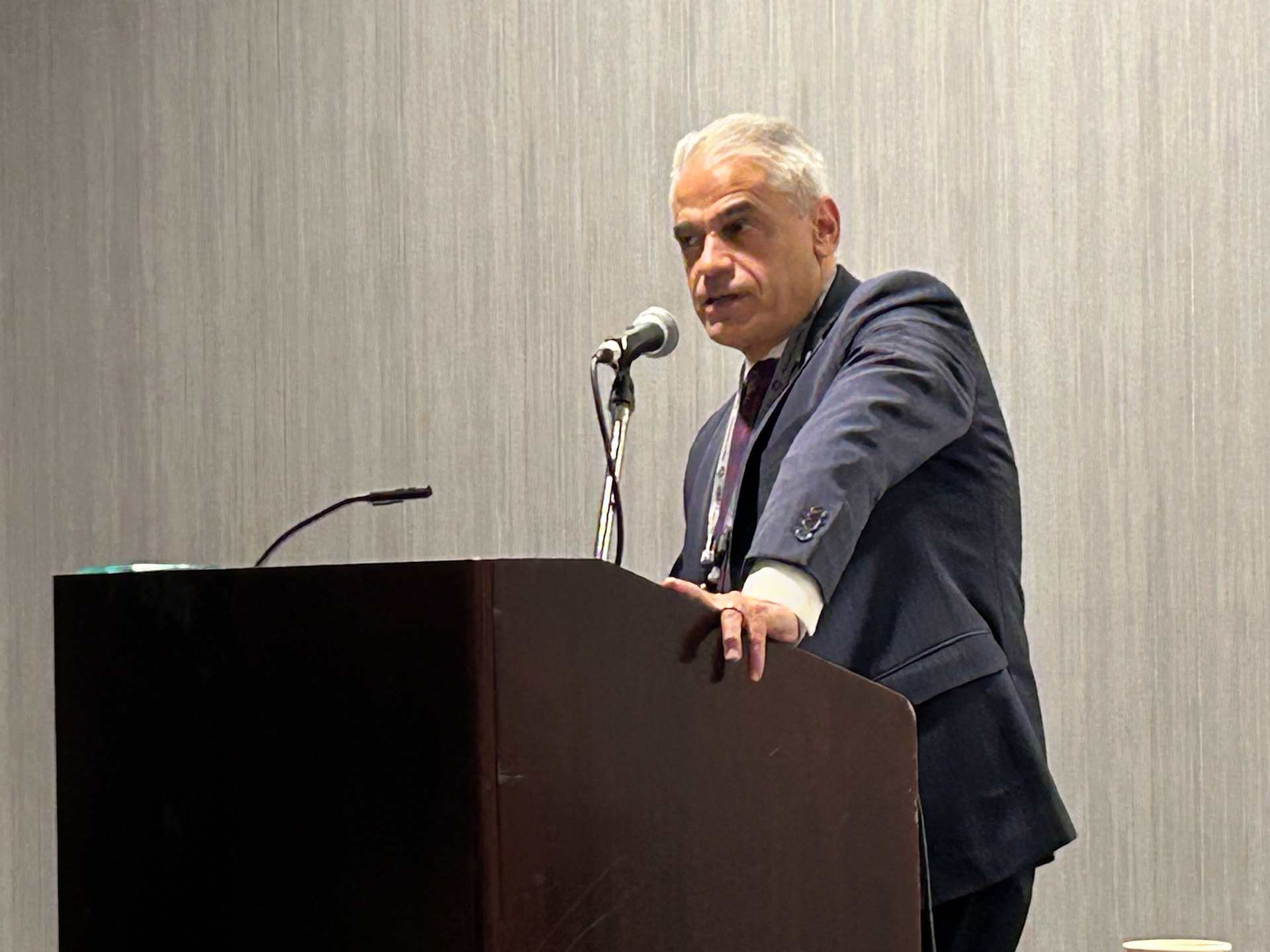
Diaz, who served as U.S. ambassador to the Holy See under former President Barack Obama, said Leo is “a different symbol, from America first to America cares.”
He emphasized that having an American pope is significant amid the country’s political debates because “he can say things and he will be listened to.”
The panelists also discussed what Leo’s papacy may look like moving forward, with Dulle noting that only this year are there clear signs of him charting his own programmatic course, as the events and itinerary of the 2025 Jubilee were primarily developed for Pope Francis.
Up until now, she said, he has been mostly “continuing the Francis initiatives in a different style.”
She noted Pope Leo's management of this week's consistory — a meeting between the pope and the College of Cardinals — where the pontiff gave them four topics to choose from, which were all in line with Francis’s priorities: synodality, evangelization, reform of the curia, and the liturgy. The cardinals chose synodality and evangelization.
Dulle said Leo is seen as "a consensus builder” who aims to build consensus around the Church's priorities. She noted Pope Leo's announcement this week of a regular schedule of consistories, with the next one set for this June. This approach is emerging as a "hallmark of how he governs the Church" Dulle said.
Brian Flanagan, the John Cardinal Cody Chair of Catholic Theology at Loyola University Chicago, also emphasized Leo’s strong appeal to the cardinals and bishops in efforts to reach consensus, in keeping with the Pope's role as a preserver of unity.
Flanagan said he sees Leo exercising the papacy as not so much "at the top of the pyramid, but as at the center of conversation.” He said this is likely influenced by Leo's past as leader of a religious order — the Order of Saint Augustine — rather than a diocese because the orders are “global, diverse, and somewhat fractious.”
“You can’t govern a global religious community without getting people on board,” he said.
St. Elena House launches in UK to help Catholics ‘catch the fire’ of God’s love
Posted on 01/10/2026 11:00 AM (EWTN News - World Catholic News)
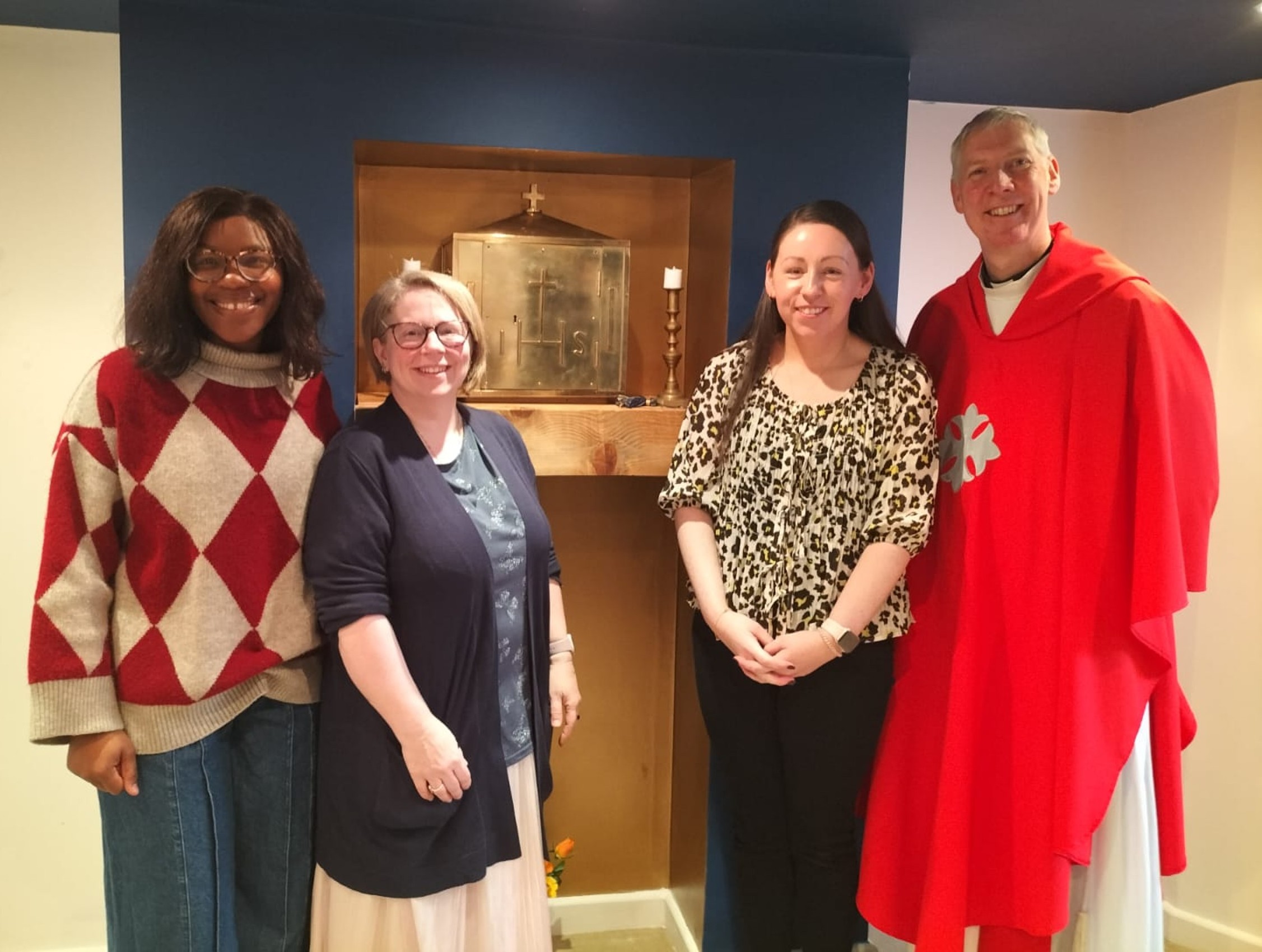 Northampton Episcopal Vicar for Mission Canon Simon Penhalagan alongside members of the new community at the St. Elena House of Mission and Prayer. | Credit: Maria Heath
Northampton Episcopal Vicar for Mission Canon Simon Penhalagan alongside members of the new community at the St. Elena House of Mission and Prayer. | Credit: Maria Heath
, Jan 10, 2026 / 09:00 am (CNA).
Northampton, England, welcomes St. Elena House, a new community focused on prayer and mission inspired by the call to a new evangelization.
CNA explains: How does the Catholic Church create dioceses and archdioceses?
Posted on 01/10/2026 08:00 AM (EWTN News - US Catholic News)
 St. Joseph Cathedral, Buffalo. | Credit: CiEll/Shutterstock
St. Joseph Cathedral, Buffalo. | Credit: CiEll/Shutterstock
Jan 10, 2026 / 06:00 am (CNA).
Catholics in the U.S. were witness to a rare Church decision in 2023 when Pope Francis elevated the Diocese of Las Vegas to a metropolitan archdiocese. Las Vegas had previously been a suffragan diocese of San Francisco, having been created by Pope John Paul II in 1995.
A suffragan diocese operates within an ecclesiastical province subordinate to a larger archdiocese and is led by a suffragan bishop who has the authority to lead his own diocese but works under the metropolitan archbishop.
In September 2025, Pope Leo XIV created a new Catholic diocese in northern China; though it goes by the same name as one established decades ago by Beijing without Vatican approval — a product of ongoing tensions between China and the Holy See — the move demonstrated the Holy See’s authority in creating local Church jurisdictions.
Outside of one’s own parish, a diocese or archdiocese is arguably the average Catholic’s most common point of interaction with the Church. These jurisdictions manage local Church life and administration, with bishops and archbishops offering both spiritual and temporal guidance and authority to Catholics under their care.
But how does the Catholic Church decide what becomes a diocese or an archdiocese? What are the roots of this ancient practice, and how does it function today?
Exclusively a papal right
Monsignor William King, JCD, KCHS, an assistant professor at the school of canon law at The Catholic University of America, told CNA that the right to erect (or suppress) a diocese “belongs exclusively to the successor of Peter, the bishop of Rome,” that is, the pope.
“Historically, secular rulers have intruded into the process and the autonomy of the Church in this action has been hard-won,” he said, pointing out that “even today in certain parts of the world, secular or civil rulers wish to have input into matters such as this.”
The pope never makes decisions regarding dioceses and archdioceses “without considerable study and consultation,” King said.
The history of diocesan administration stretches back to the earliest years of the Church, he said. In those days a diocese consisted of “a city larger than the surrounding cities and towns,” often a place of commerce or a center of government.
Throughout the centuries, including after the imperial legalization of the Church by Constantine, Church leaders refined the diocesan structure of “pastoral ministry and governance” in order to facilitate “communication and decision-making” throughout Christendom.
“This became increasingly important as the Church grew and encountered different systems of law, philosophy, and religious practice,” King said. Roman models of government structure proved useful and sufficient for Church governance; King noted that the Church structure even today more closely resembles a government than a corporation.
The process by determining which jurisdictions counted as archdioceses likely arose in earlier centuries organically, King said, with Church leaders identifying major centers of “culture, education, commerce, government, and transportation” as particularly significant jurisdictions.
The procedure for elevating a diocese to an archdiocese, meanwhile — as Pope Francis did to Las Vegas in 2023 — requires “significant study, discussion, and decision-making,” King said.
The Holy See conducts such reviews in part through a diocese’s “quinquennial report,” a detailed rundown of the diocese’s activities and administration. Such a report may indicate to the Holy See that a particular region is growing and could benefit from elevation to an archdiocese.
Local suffragan bishops will participate in discussions to that effect, King said, and the Roman Curia will work with bishops’ conferences as well as the local apostolic nuncio.
“The ultimate decision is that of the Roman pontiff, the bishop of Rome,” King said, “but is always done with his awareness of the conversations and consultations already conducted at every level.”
The priest pointed out that not every local jurisdiction of the Church is a diocese or archdiocese. At times, he said, the pope may establish a less common ecclesiastical administration “for a variety of reasons that relate to culture, legal acceptance or opposition, small numbers, and the like.”
Such jurisdictions include apostolic prefectures, apostolic vicariates, ordinariates, and other designations. Such areas may be governed by a bishop or a priest named by the pope, King said.
Madrid, Barcelona, Canary Islands possible destinations for Pope Leo XIV in 2026
Posted on 01/9/2026 19:06 PM (EWTN News - World Catholic News)
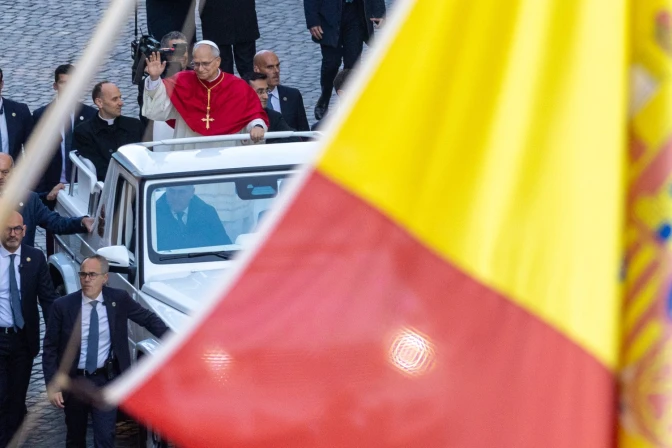 Pope Leo XIV with the Spanish flag in the foreground on Dec. 8, 2025. | Credit: Daniel Ibáñez/EWTN News
Pope Leo XIV with the Spanish flag in the foreground on Dec. 8, 2025. | Credit: Daniel Ibáñez/EWTN News
, Jan 9, 2026 / 17:06 pm (CNA).
Madrid, Barcelona, and the Canary Islands are likely destinations in 2026 for Pope Leo XIV to visit.
Spain, Catholic Church sign agreement to compensate victims of sexual abuse
Posted on 01/9/2026 18:28 PM (EWTN News - World Catholic News)
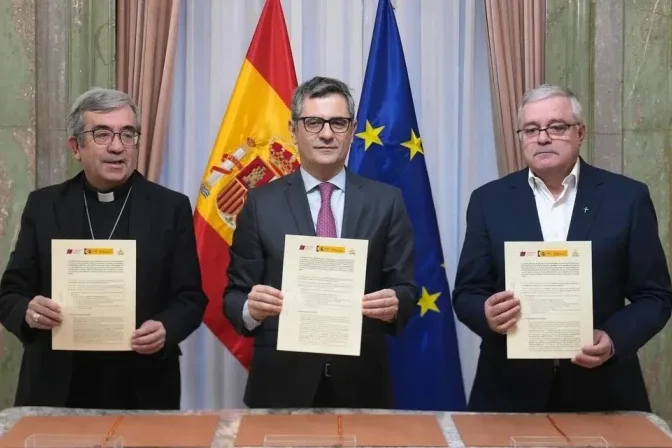 Archbishop Luis Argüello, president of the Spanish Bishops’ Conference; Félix Bolaños, minister of the Presidency, Justice, and Relations with the Parliament; and Father Jesús Díaz Sariego, OP, president of CONFER. | Credit: Ministry of the Presidency
Archbishop Luis Argüello, president of the Spanish Bishops’ Conference; Félix Bolaños, minister of the Presidency, Justice, and Relations with the Parliament; and Father Jesús Díaz Sariego, OP, president of CONFER. | Credit: Ministry of the Presidency
, Jan 9, 2026 / 16:28 pm (CNA).
The Church and the Spanish government have signed an agreement to provide a channel for compensating victims of sexual abuse.
President of Venezuelan bishops’ conference: We are living in a ‘tense calm’
Posted on 01/9/2026 09:00 AM (EWTN News - Americas Catholic News)
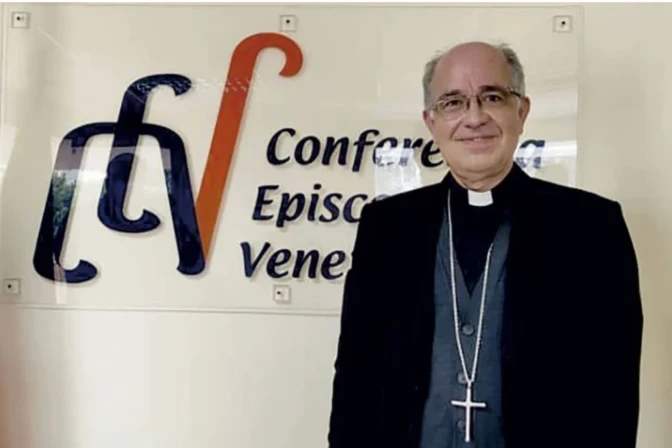 Archbishop Jesús González de Zárate, president of the Venezuelan Bishops’ Conference | Credit: Venezuelan Bishops’ Conference
Archbishop Jesús González de Zárate, president of the Venezuelan Bishops’ Conference | Credit: Venezuelan Bishops’ Conference
, Jan 9, 2026 / 07:00 am (CNA).
Following the U.S. attack Jan. 3 on Venezuela and the capture of its president and his wife, the country is experiencing a “tense calm,” Archbishop Jesús González de Zárate said.
After Maduro’s capture, there’s hope for Venezuela, Nicaragua, and Cuba, leader says
Posted on 01/8/2026 20:10 PM (EWTN News - Americas Catholic News)
 Artist’s sketch of Nicolás Maduro and Cilia Flores at the New York courthouse where they appeared Jan. 5, 2025. Photos and videos are prohibited, hence this illustration, but journalists are allowed to be present. | Credit: CNN
Artist’s sketch of Nicolás Maduro and Cilia Flores at the New York courthouse where they appeared Jan. 5, 2025. Photos and videos are prohibited, hence this illustration, but journalists are allowed to be present. | Credit: CNN
, Jan 8, 2026 / 18:10 pm (CNA).
With Maduro’s capture, people of Venezuela, Cuba, and Nicaragua have reason to hope for change, according to the former Nicaraguan ambassador to the Organization of American States (OAS).
‘Making room for God’: MEHR conference draws over 11,000 in Germany
Posted on 01/8/2026 17:06 PM (EWTN News - World Catholic News)
 Participants gather for worship at the MEHR conference in Augsburg, Germany, Jan. 3–6, 2026. | Credit: Andreas Thonhauser/EWTN
Participants gather for worship at the MEHR conference in Augsburg, Germany, Jan. 3–6, 2026. | Credit: Andreas Thonhauser/EWTN
, Jan 8, 2026 / 15:06 pm (CNA).
The four-day MEHR conference drew participants from across the European continent to hear from international speakers, including American presenters.
